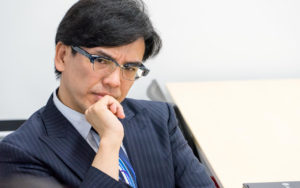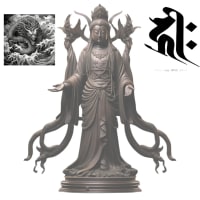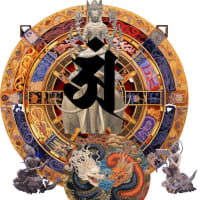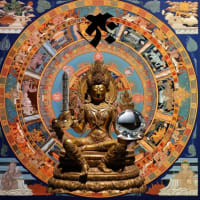地球レベルを超え、銀河レベル、宇宙レベルのネットワークが構築され、そこに知性が誕生すると予言したレイ・カーツワイル氏。彼の予言が本当に実現するのかどうかは科学技術の進歩にかかっていると言っていいだろう。
そしていまを生きる我々は、素晴らしいタイミングを迎えようとしている。シンギュラリティを迎える瞬間、を目撃しようとしているのだ。
2045年人工知能が全人類の知識を超える「シンギュラリティ」が起こるとされているが、もしかするとこれは大幅に前倒しになるかもしれない。

渡辺 健太郎(以下渡辺):時間軸がすごく短くなっていて、エクサスケールのコンピューターが2020年にはできているだろうと、そこから10年でプレシンギュラリティに向かっていくと書かれていましたが。
齊藤元章(以下齊藤):それはもう、ちょっと古いかなと思っています。時間軸が圧縮されてきていますから。
渡辺:なるほど、そのアップデートを教えていただけると。
齊藤:エクサスケールのスパコンは2018年中にはできると思います。
渡辺:え、2018年ですか。
齊藤:中国は2019年から2020年にかけて異なるシステムを3台も立ち上げようとしています。
そこからプレシンギュラリティは10年かけてと言っていたのですが、たぶん5年かからないと思います。
本を書いたときには、もちろんAIはある程度意識してはいたんですが、ここまでAIが急速に進歩するとは思ってもみませんでした。
渡辺:著書では、ハード中心に書かれていましたよね。
齊藤:もちろんハードも重要で、AIをもっと加速させようとすると、AI専用のエンジンをつくらないといけないと思って、最近新しい会社を立ち上げたところです。
AIとスパコンって、実は人智を超えた最強のタッグを組めるんですよ。
いまAIが何をしているのかというと、特徴点・特徴量、つまりパターンの抽出です。
AIが将棋で人間に勝ちました、碁でも勝ちました、人間に分からなかった病気を診断しました、といったニュースが出てきていますけれど、まだぜんぜん序の口なんです。
次なにができるかというと、いまの1000倍くらいAIのエンジンが速くなると、複雑な社会的事象も、自然科学的な事象も含めて、それらの膨大な事象の中からたくさんのパターンを抽出して、それを改めて全部ならべてみて高い視点から俯瞰したときに、そこには何かしらの新しい規則性、法則性が必ず見つかるはずです。
これは、要するに新しい仮説を立案したことになります。
今年の科学界の非常に大きなトピックの1つに重力波の検出があります。昨年の9月に1回、12月にも1回検出されていたことが今年の3月と6月に発表されて、大変な話題となりました。
重力波は存在するという仮説は100年前から存在していたのです。
実験でもありそうだとされていましたが、結局、直接は検出されていなかったので、重力波は理論として100%になっていなかったのです。
こうした仮説は、必ず検証しないと理論になりません。
で検証ってどうやるのかというと、重力波の検出もそうでしたが、実験設備を作って初めて検証できるんです。机上の計算で検証できるものもありますし、コンピューター上できるものもありますが、多くの場合には実際に実験系を作らないといけない。
ただ仮説が高度化してくると、その実験設備が巨大かつ複雑になって、しかもものすごく高い精度でつくらないといけない。それには、とにかくお金とひとと時間がかかります。
人工知能が仮説を立案してくるようなると、とんでもない数の仮説を立案してくるのに加えて、ものすごく複雑な仮説を立案してきます。
たぶん、その多くは人間には理解できないでしょう。
同じ人間であっても、例えば天才アインシュタインの特殊相対性理論や一般相対性理論を、一体どれだけのひとが理解しているのか、ということがありますよね。
宇宙には、自然界に存在する四つの力を全て統合して表すことができる「統一場理論」があるはずだと言われながら、人間はそこにまだまだ追い付いていないわけです。
仮説の大半は棄却されるので、100に1個、1万に1個しか検証されないかもしれない。
その度に大型で複雑な実験系を作るのは、物理的に到底不可能です。ところがエクサフロップス級のスパコンがあると、スパコンの中のバーチャルな物理空間に実験系を、現実空間よりも高い精度でつくることができるようになります。そして、そこで検証を行えるようになるんです。
次世代の人工知能エンジンに、とにかく仮説をたくさん立案させて、かたっぱしからスパコンをまわして検証を行う。多くは棄却されたり、修正されたりすることになりますが、このループがまわっていくと、人智をはるかに超えた仮説が検証されて、やがては統一場理論も検証できるようになっていくはずなのです。
渡辺:それは恐ろしいかもしれない(笑)
齊藤:これは本を書いたときは想定していなかったことですね。
いまの1000倍高速な人工知能エンジンを2018年中には完成させようとしていて、2019年にはこのループをまわし始めることができるんです。
渡辺:2019年からプレシンギュラリティに向かって走り始めるということですよね。
齊藤:世の中の理解もこのペースで進んでいるとすれば、2年後3年後でかなりいいところまで行くと思います。
ボトムアップでの理解が深まると同時にトップダウンで国の政権トップのレベルから始まって、浸透していくとすればもう2025年にはプレシンギュラリティ実現という可能性はかなりあるんじゃないかと。
渡辺:2025年ですか。
齊藤:それで2030年にはシンギュラリティに至っていると思います。
渡辺:15年も前倒しになりますね。
15年前倒しとなり2030年にはシンギュラリティが実現する可能性が見えてきた。
エクサレベルのスパコンとタッグを組んだ人工知能がどのような仮説を立て、検証するのか非常に楽しみだ。
人工知能により宇宙のメカニズムが解明されれば、カーツワイル氏の予言する「第6段階」に到達することも現実味を帯びてくる。
しかしこのような未来を実現する前に、貧困や戦争、そして地球温暖化などいまわれわれが取り組まなくてはならい課題があることを忘れてはならない。
最終回となる次回は、われわれが直面する課題に人工知能やスパコンがどこまで挑戦できるのか、その可能性を探った。
Ray Kurzweil predicted that a network of the galaxy level and the cosmic level would be built beyond the earth level, and intelligence would be born there. It can be said that his prophecy really depends on scientific and technological progress.
And we who are living now are going to have a wonderful time. I'm trying to witness the moment of singularity.
In 2045, it is said that “singularity” will occur where artificial intelligence surpasses the knowledge of all mankind, but this may be greatly advanced.
5 years after the arrival of presingularity
Kentaro Watanabe (Watanabe): It was written that the time axis was very short and that an exascale computer would be ready in 2020, and that it would go to presingularity in 10 years from there. But.
Motoaki Saito (hereinafter Saito): I think it's a bit old. Because the time axis has been compressed.
Watanabe: I hope you can tell me about the update.
Saito: I think that an exascale supercomputer will be available in 2018.
Watanabe: Oh, is it 2018?
Saito: China is about to launch three different systems from 2019 to 2020.
From that point, I said that presingularity took 10 years, but I think it will probably not take 5 years.
Of course, when I wrote a book, I was conscious of AI to some extent, but I didn't expect AI to progress so far.
Watanabe: In your book, it was written mainly on hardware.
Saito: Of course, hardware is also important, and in order to accelerate AI further, we have recently established a new company, thinking that we have to create an engine dedicated to AI.
AI and supercomputers can actually form the strongest tag beyond human intelligence.
What AI is doing now is the extraction of feature points / features, that is, patterns.
There have been news that AI has won humans with shogi, even with samurai, and has diagnosed illnesses that humans did not understand, but it is still just the beginning.
What can be done next is that when the AI engine is about 1000 times faster than today, many patterns will be extracted from these enormous events, including complex social events and natural scientific events. Then, when you look at all of them and take a bird's-eye view from a high point of view, you will surely find some new regularity and law.
This is essentially a new hypothesis.
One of the very big topics of the scientific community this year is the detection of gravity waves. The fact that it was detected once in September last year and once in December was announced in March and June of this year, and it became a big topic.
The hypothesis that gravitational waves exist has existed 100 years ago.
Although it was supposed to be an experiment, it was not detected directly in the end, so gravitational waves were not 100% in theory.
Such a hypothesis must be verified before it becomes a theory.
As for the verification method, the detection of gravitational waves was the same, but it can only be verified after an experimental facility is built. There are things that can be verified by calculation on the desk, and others that can be done on a computer, but in many cases you have to actually create an experimental system.
However, as the hypotheses become more sophisticated, the experimental facilities become huge and complex, and must be made with extremely high accuracy. It takes money, people and time.
When artificial intelligence comes up with a hypothesis, in addition to making a ridiculous number of hypotheses, it makes a very complex hypothesis.
Perhaps many of them will not be understood by humans.
Even if you are the same person, for example, how many people understand the special relativity theory and general relativity theory of Einstein, for example?
It is said that there must be a “unified field theory” in the universe that can integrate and express all four forces that exist in nature, but humans have not yet caught up there.
Most of the hypotheses are rejected, so only one in 100 and one in 10,000 might be verified.
It is physically impossible to make a large and complex experimental system each time. However, with an exaflop-class supercomputer, it becomes possible to create an experimental system in a virtual physical space inside the supercomputer with higher accuracy than in real space. And then you can verify it there.
The next-generation artificial intelligence engine will make a lot of hypotheses anyway, and it will be verified by turning the supercomputer. Many will be rejected or modified, but as this loop turns, hypotheses far beyond human wisdom are verified, and eventually unified field theory can be verified. It should be.
Watanabe: That may be horrible (laughs)
Saito: That was something you didn't expect when you wrote the book.
The artificial intelligence engine that is 1000 times faster than now is going to be completed in 2018, and in 2019, we can start turning this loop.
Watanabe: That means starting to run toward presingularity in 2019.
Saito: If the understanding of the world is progressing at this pace, I think that it will go to a very good place in two years, three years.
If the understanding from the bottom-up deepens and starts from the top level of the government in the top-down, and penetrates, the possibility of realizing presingularity is already in 2025.
Watanabe: Is it 2025?
Saito: So I think that in 2030, it reached singularity.
Watanabe: That will be 15 years ahead.
It was 15 years ahead of schedule, and in 2030 the possibility of realizing singularity has become apparent.
I'm really looking forward to seeing what hypothesis is made by artificial intelligence, which is a combination of exa-level supercomputers and tags.
If the mechanism of the universe is elucidated by artificial intelligence, reaching the “sixth stage” predicted by Mr. Kurzweil will become realistic.
But before realizing this future, we must remember that there are issues we must tackle now, such as poverty, war, and global warming.
In the final round, we explored the potential of artificial intelligence and supercomputers to challenge the challenges we face.
そしていまを生きる我々は、素晴らしいタイミングを迎えようとしている。シンギュラリティを迎える瞬間、を目撃しようとしているのだ。
2045年人工知能が全人類の知識を超える「シンギュラリティ」が起こるとされているが、もしかするとこれは大幅に前倒しになるかもしれない。

プレシンギュラリティ到来は5年後
渡辺 健太郎(以下渡辺):時間軸がすごく短くなっていて、エクサスケールのコンピューターが2020年にはできているだろうと、そこから10年でプレシンギュラリティに向かっていくと書かれていましたが。
齊藤元章(以下齊藤):それはもう、ちょっと古いかなと思っています。時間軸が圧縮されてきていますから。
渡辺:なるほど、そのアップデートを教えていただけると。
齊藤:エクサスケールのスパコンは2018年中にはできると思います。
渡辺:え、2018年ですか。
齊藤:中国は2019年から2020年にかけて異なるシステムを3台も立ち上げようとしています。
そこからプレシンギュラリティは10年かけてと言っていたのですが、たぶん5年かからないと思います。
本を書いたときには、もちろんAIはある程度意識してはいたんですが、ここまでAIが急速に進歩するとは思ってもみませんでした。
渡辺:著書では、ハード中心に書かれていましたよね。
齊藤:もちろんハードも重要で、AIをもっと加速させようとすると、AI専用のエンジンをつくらないといけないと思って、最近新しい会社を立ち上げたところです。
AIとスパコンって、実は人智を超えた最強のタッグを組めるんですよ。
いまAIが何をしているのかというと、特徴点・特徴量、つまりパターンの抽出です。
AIが将棋で人間に勝ちました、碁でも勝ちました、人間に分からなかった病気を診断しました、といったニュースが出てきていますけれど、まだぜんぜん序の口なんです。
次なにができるかというと、いまの1000倍くらいAIのエンジンが速くなると、複雑な社会的事象も、自然科学的な事象も含めて、それらの膨大な事象の中からたくさんのパターンを抽出して、それを改めて全部ならべてみて高い視点から俯瞰したときに、そこには何かしらの新しい規則性、法則性が必ず見つかるはずです。
これは、要するに新しい仮説を立案したことになります。
今年の科学界の非常に大きなトピックの1つに重力波の検出があります。昨年の9月に1回、12月にも1回検出されていたことが今年の3月と6月に発表されて、大変な話題となりました。
重力波は存在するという仮説は100年前から存在していたのです。
実験でもありそうだとされていましたが、結局、直接は検出されていなかったので、重力波は理論として100%になっていなかったのです。
こうした仮説は、必ず検証しないと理論になりません。
で検証ってどうやるのかというと、重力波の検出もそうでしたが、実験設備を作って初めて検証できるんです。机上の計算で検証できるものもありますし、コンピューター上できるものもありますが、多くの場合には実際に実験系を作らないといけない。
ただ仮説が高度化してくると、その実験設備が巨大かつ複雑になって、しかもものすごく高い精度でつくらないといけない。それには、とにかくお金とひとと時間がかかります。
人工知能が仮説を立案してくるようなると、とんでもない数の仮説を立案してくるのに加えて、ものすごく複雑な仮説を立案してきます。
たぶん、その多くは人間には理解できないでしょう。
同じ人間であっても、例えば天才アインシュタインの特殊相対性理論や一般相対性理論を、一体どれだけのひとが理解しているのか、ということがありますよね。
宇宙には、自然界に存在する四つの力を全て統合して表すことができる「統一場理論」があるはずだと言われながら、人間はそこにまだまだ追い付いていないわけです。
仮説の大半は棄却されるので、100に1個、1万に1個しか検証されないかもしれない。
その度に大型で複雑な実験系を作るのは、物理的に到底不可能です。ところがエクサフロップス級のスパコンがあると、スパコンの中のバーチャルな物理空間に実験系を、現実空間よりも高い精度でつくることができるようになります。そして、そこで検証を行えるようになるんです。
次世代の人工知能エンジンに、とにかく仮説をたくさん立案させて、かたっぱしからスパコンをまわして検証を行う。多くは棄却されたり、修正されたりすることになりますが、このループがまわっていくと、人智をはるかに超えた仮説が検証されて、やがては統一場理論も検証できるようになっていくはずなのです。
渡辺:それは恐ろしいかもしれない(笑)
齊藤:これは本を書いたときは想定していなかったことですね。
いまの1000倍高速な人工知能エンジンを2018年中には完成させようとしていて、2019年にはこのループをまわし始めることができるんです。
渡辺:2019年からプレシンギュラリティに向かって走り始めるということですよね。
齊藤:世の中の理解もこのペースで進んでいるとすれば、2年後3年後でかなりいいところまで行くと思います。
ボトムアップでの理解が深まると同時にトップダウンで国の政権トップのレベルから始まって、浸透していくとすればもう2025年にはプレシンギュラリティ実現という可能性はかなりあるんじゃないかと。
渡辺:2025年ですか。
齊藤:それで2030年にはシンギュラリティに至っていると思います。
渡辺:15年も前倒しになりますね。
15年前倒しとなり2030年にはシンギュラリティが実現する可能性が見えてきた。
エクサレベルのスパコンとタッグを組んだ人工知能がどのような仮説を立て、検証するのか非常に楽しみだ。
人工知能により宇宙のメカニズムが解明されれば、カーツワイル氏の予言する「第6段階」に到達することも現実味を帯びてくる。
しかしこのような未来を実現する前に、貧困や戦争、そして地球温暖化などいまわれわれが取り組まなくてはならい課題があることを忘れてはならない。
最終回となる次回は、われわれが直面する課題に人工知能やスパコンがどこまで挑戦できるのか、その可能性を探った。
Ray Kurzweil predicted that a network of the galaxy level and the cosmic level would be built beyond the earth level, and intelligence would be born there. It can be said that his prophecy really depends on scientific and technological progress.
And we who are living now are going to have a wonderful time. I'm trying to witness the moment of singularity.
In 2045, it is said that “singularity” will occur where artificial intelligence surpasses the knowledge of all mankind, but this may be greatly advanced.
5 years after the arrival of presingularity
Kentaro Watanabe (Watanabe): It was written that the time axis was very short and that an exascale computer would be ready in 2020, and that it would go to presingularity in 10 years from there. But.
Motoaki Saito (hereinafter Saito): I think it's a bit old. Because the time axis has been compressed.
Watanabe: I hope you can tell me about the update.
Saito: I think that an exascale supercomputer will be available in 2018.
Watanabe: Oh, is it 2018?
Saito: China is about to launch three different systems from 2019 to 2020.
From that point, I said that presingularity took 10 years, but I think it will probably not take 5 years.
Of course, when I wrote a book, I was conscious of AI to some extent, but I didn't expect AI to progress so far.
Watanabe: In your book, it was written mainly on hardware.
Saito: Of course, hardware is also important, and in order to accelerate AI further, we have recently established a new company, thinking that we have to create an engine dedicated to AI.
AI and supercomputers can actually form the strongest tag beyond human intelligence.
What AI is doing now is the extraction of feature points / features, that is, patterns.
There have been news that AI has won humans with shogi, even with samurai, and has diagnosed illnesses that humans did not understand, but it is still just the beginning.
What can be done next is that when the AI engine is about 1000 times faster than today, many patterns will be extracted from these enormous events, including complex social events and natural scientific events. Then, when you look at all of them and take a bird's-eye view from a high point of view, you will surely find some new regularity and law.
This is essentially a new hypothesis.
One of the very big topics of the scientific community this year is the detection of gravity waves. The fact that it was detected once in September last year and once in December was announced in March and June of this year, and it became a big topic.
The hypothesis that gravitational waves exist has existed 100 years ago.
Although it was supposed to be an experiment, it was not detected directly in the end, so gravitational waves were not 100% in theory.
Such a hypothesis must be verified before it becomes a theory.
As for the verification method, the detection of gravitational waves was the same, but it can only be verified after an experimental facility is built. There are things that can be verified by calculation on the desk, and others that can be done on a computer, but in many cases you have to actually create an experimental system.
However, as the hypotheses become more sophisticated, the experimental facilities become huge and complex, and must be made with extremely high accuracy. It takes money, people and time.
When artificial intelligence comes up with a hypothesis, in addition to making a ridiculous number of hypotheses, it makes a very complex hypothesis.
Perhaps many of them will not be understood by humans.
Even if you are the same person, for example, how many people understand the special relativity theory and general relativity theory of Einstein, for example?
It is said that there must be a “unified field theory” in the universe that can integrate and express all four forces that exist in nature, but humans have not yet caught up there.
Most of the hypotheses are rejected, so only one in 100 and one in 10,000 might be verified.
It is physically impossible to make a large and complex experimental system each time. However, with an exaflop-class supercomputer, it becomes possible to create an experimental system in a virtual physical space inside the supercomputer with higher accuracy than in real space. And then you can verify it there.
The next-generation artificial intelligence engine will make a lot of hypotheses anyway, and it will be verified by turning the supercomputer. Many will be rejected or modified, but as this loop turns, hypotheses far beyond human wisdom are verified, and eventually unified field theory can be verified. It should be.
Watanabe: That may be horrible (laughs)
Saito: That was something you didn't expect when you wrote the book.
The artificial intelligence engine that is 1000 times faster than now is going to be completed in 2018, and in 2019, we can start turning this loop.
Watanabe: That means starting to run toward presingularity in 2019.
Saito: If the understanding of the world is progressing at this pace, I think that it will go to a very good place in two years, three years.
If the understanding from the bottom-up deepens and starts from the top level of the government in the top-down, and penetrates, the possibility of realizing presingularity is already in 2025.
Watanabe: Is it 2025?
Saito: So I think that in 2030, it reached singularity.
Watanabe: That will be 15 years ahead.
It was 15 years ahead of schedule, and in 2030 the possibility of realizing singularity has become apparent.
I'm really looking forward to seeing what hypothesis is made by artificial intelligence, which is a combination of exa-level supercomputers and tags.
If the mechanism of the universe is elucidated by artificial intelligence, reaching the “sixth stage” predicted by Mr. Kurzweil will become realistic.
But before realizing this future, we must remember that there are issues we must tackle now, such as poverty, war, and global warming.
In the final round, we explored the potential of artificial intelligence and supercomputers to challenge the challenges we face.
























※コメント投稿者のブログIDはブログ作成者のみに通知されます